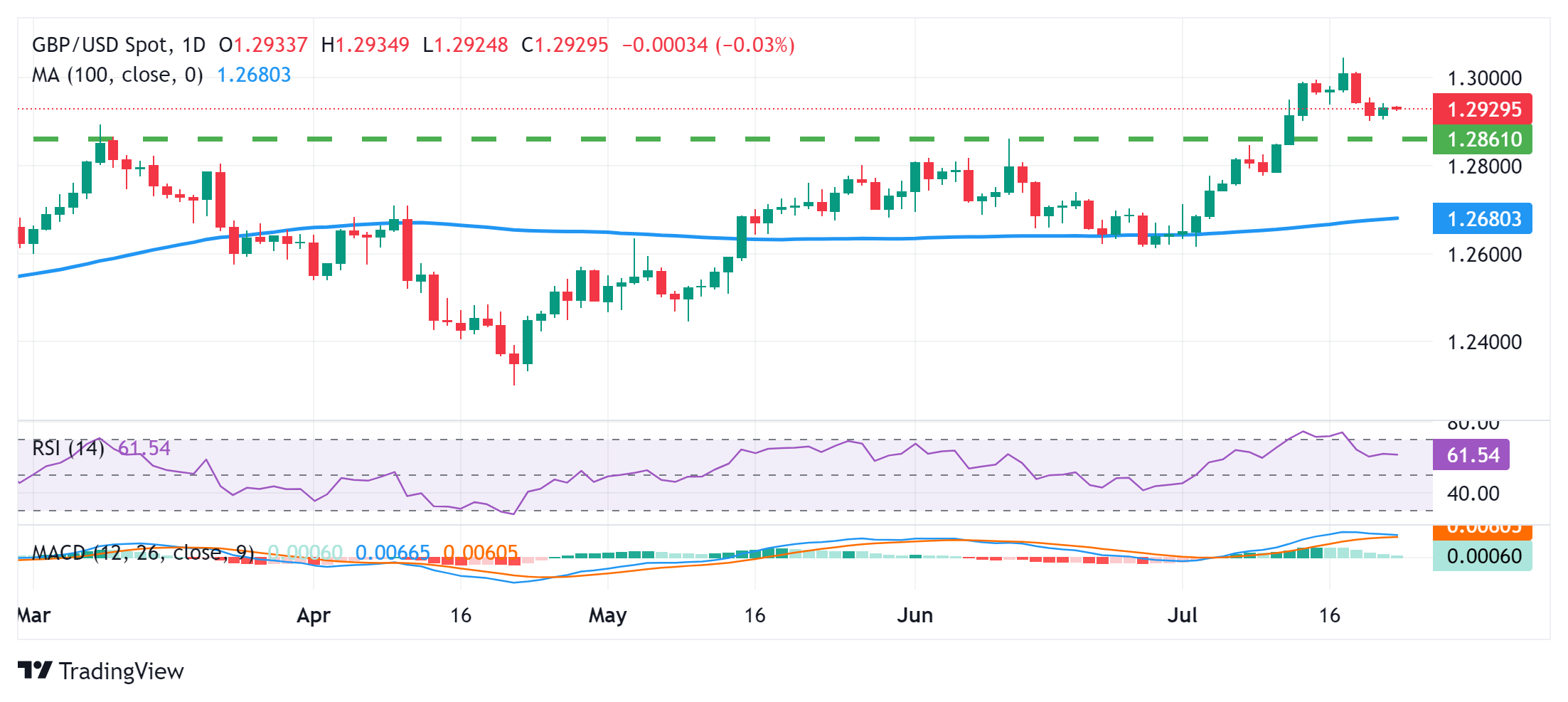- GBP/USD lacks firm intraday direction and is hovering in a tight range on Tuesday.
- The fundamental background and technical setup seem to be tilting in favor of the bulls.
- A convincing break below the 1.2900 level is needed to negate the positive bias.
The GBP/USD pair fails to build on the previous day’s modest rebound from the 1.2900 area and is hovering within a tight range during the Asian session on Tuesday. Spot prices are currently hovering around the 1.2930 area, almost unchanged on the day, and remain at the mercy of the US Dollar (USD) price dynamics.
Investors have fully priced in an interest rate cut by the Federal Reserve (Fed) at the September policy meeting, keeping US Treasury yields depressed. This, in turn, triggers some USD selling and turns out to be a key factor acting as a tailwind for the GBP/USD pair. In addition to this, the decreasing chances of an interest rate cut by the Bank of England (BoE) in August is offering some support to the currency pair.
From a technical perspective, the recent break through the previous yearly high, around the 1.2895 region, was seen as a fresh trigger for bullish traders. Moreover, the Relative Strength Index (RSI) on the daily chart has declined from the overbought zone and is holding comfortably in the positive territory. This validates the positive outlook and suggests that the path of least resistance for the GBP/USD pair is to the upside.
A follow-through strength beyond the immediate hurdle of 1.2960-1.2965 will reaffirm the constructive setup and allow the bulls to reclaim the psychological level of 1.3000. The subsequent upside move has the potential to take the GBP/USD pair back towards the yearly high, around the 1.3045 zone touched last week. The momentum could extend further towards the 1.3100 level en route to the July 2023 high, around the 1.3140 region.
On the other hand, bearish traders need to wait for a sustained break and acceptance below the 1.2900 level before opening fresh positions. The said level should now act as a pivotal point, below which the GBP/USD pair could decline further towards the intermediate support near the 1.2855 zone before eventually falling to the 1.2820-1.2815 region and the 1.2800 level.
GBP/USD daily chart
The British Pound FAQs
The Pound Sterling (GBP) is the oldest currency in the world (886 AD) and the official currency of the United Kingdom. It is the fourth most traded currency unit in the world, accounting for 12% of all transactions and an average of $630 billion a day, as of 2022.
Its key currency pairs are GBP/USD, also known as the “Cable,” which accounts for 11% of the forex market, GBP/JPY, or the “Dragon” as it is known to traders (3%), and EUR/GBP (2%). The British Pound is issued by the Bank of England (BoE).
The most important factor influencing the value of the British Pound is the monetary policy decided by the Bank of England. The Bank of England bases its decisions on achieving its main objective of “price stability”, i.e. a stable inflation rate of around 2%. Its main tool for achieving this is the adjustment of interest rates.
When inflation is too high, the Bank of England tries to contain it by raising interest rates, making credit more expensive for individuals and businesses. This is generally positive for the GBP, as higher interest rates make the UK a more attractive place for global investors to park their money.
When inflation is too low, it is a sign that economic growth is slowing. In this scenario, the BoE will consider lowering interest rates to make credit cheaper, so that companies borrow more to invest in growth-generating projects.
The data released gauges the health of the economy and can influence the value of the Pound. Indicators such as GDP, manufacturing and services PMIs, and employment can influence the direction of the Pound.
A strong economy is good for the British Pound. Not only does it attract more foreign investment, but it may encourage the Bank of England to raise interest rates, which will directly strengthen the British Pound. Conversely, if economic data is weak, the British Pound is likely to fall.
Another significant indicator for the pound is the trade balance. This indicator measures the difference between what a country earns from its exports and what it spends on imports during a given period.
If a country produces highly sought-after exports, its currency will benefit exclusively from the additional demand created by foreign buyers who wish to purchase these goods. Therefore, a positive net trade balance strengthens a currency and vice versa for a negative balance.
Source: Fx Street
I am Joshua Winder, a senior-level journalist and editor at World Stock Market. I specialize in covering news related to the stock market and economic trends. With more than 8 years of experience in this field, I have become an expert in financial reporting.








